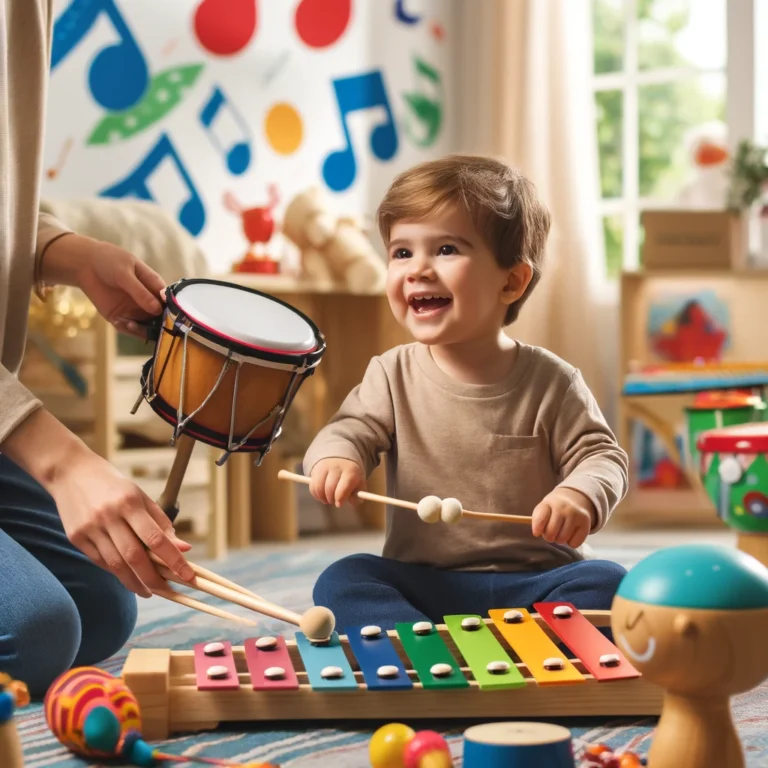
THE ROLE OF MUSIC AND PLAY IN EARLY SPEECH DEVELOPMENT
Introduction
Music and play are essential in early childhood development, particularly in fostering speech and language skills. From infancy through the preschool years, musical activities offer engaging and effective ways to support a child’s communication abilities. This article explores the multifaceted benefits of integrating music and play into early speech development.
Enhancing Early Speech and Language Development through Music Play
Music is a powerful tool in early speech and language development. Here’s how musical activities contribute to various aspects of communication skills in young children:
- Imitation Skills: Children imitate sounds, movements, and facial expressions during musical play, which is fundamental for language acquisition.
- Eye Contact and Social Engagement: Musical interactions encourage children to maintain eye contact and engage socially, promoting effective communication.
- Vocal Play and Sound Development: Babies and toddlers babble and make sounds during musical activities, laying the groundwork for speech.
- Timing and Rhythm: Associating patterns with music helps children grasp concepts of timing and rhythm, crucial for speech fluency.
- Attention and Listening Skills: Musical stimuli capture children’s attention, enhancing their listening and concentration abilities.
- Understanding Nonverbal Communication: Music and gestures convey meaning, aiding children in interpreting nonverbal cues.
- Supporting Verbal Language: Musical experiences help children understand and use verbal language, including words, instructions, and concepts.
- Expanding Vocabulary: Song lyrics and rhymes introduce new words and phrases, enriching children’s vocabulary.
- Dialogic Turn-Taking: Musical play provides opportunities for practicing turn-taking and dialogue, essential for conversations.
- Memory and Sequencing Skills: Songs and rhythmic patterns enhance memory and sequencing abilities.
- Following Directions: Dancing and playing instruments teach children how to follow directions.
- Self-Expression: Creative movement and musical activities allow children to express themselves freely.
Incorporating Music in Daily Routines for Speech Development
Integrating music, rhythm, and movement into early childhood environments not only makes learning enjoyable but also builds critical language-supporting skills in engaging and memorable ways. Here’s how to do it:
- Nursery Rhymes for Early Speech Development: Great for vocabulary, rhythm, and repetition.
- Examples: “Twinkle Twinkle Little Star,” “The Wheels on the Bus,” “Itsy Bitsy Spider.”
- Toddler Songs for Language Acquisition: Fun, interactive songs that teach concepts.
- Examples: “Baby Shark,” “If You’re Happy and You Know It,” “Old MacDonald Had a Farm.”
- Preschool Songs for Vocabulary Expansion: Expand vocabulary and lessons.
- Examples: “Rainbow Connection,” “Skidamarink,” “You’ve Got a Friend in Me.”
Case Studies on Music for Speech and Language Development
Here are two examples illustrating how specific songs can aid speech and language development in children:
Samantha: “Wheels on the Bus” for Early Speech Skills
Samantha is a 2-year-old working on increasing her expressive vocabulary, mimicking actions, and practicing turn-taking conversations. Singing “Wheels on the Bus” helps Samantha in the following ways:
- Expressive Vocabulary: Learning sounds like “wah wah” in context.
- Mimicking Actions: Copying actions like “round and round.”
- Turn-Taking: Practicing conversational skills through pauses in the song.
Michael: “Itsy Bitsy Spider” for Speech Therapy
Michael is a 4-year-old with childhood apraxia of speech. Singing “Itsy Bitsy Spider” helps improve his oral motor planning through:
- Repetition and Structure: Providing a consistent sequence of words and gestures.
- Visual and Auditory Cues: Enhancing coordination through rhythmic motions.
- Confidence Building: Encouraging speech production in a fun context.
Using Music in Speech Therapy for All Ages
Music can benefit speech therapy across all ages, from school-aged children to adults and the geriatric population. Here’s how:
- School-Age Children & Teens: Music aids in speech sound production, vocabulary building, and social communication.
- Adults: Music therapy techniques, such as songwriting, help with word retrieval and language rebuilding.
- Geriatric Population: Singing songs from earlier eras helps access speech and language skills in older adults with dementia.
Conclusion
Music is an evidence-based therapeutic tool that enhances speech and language development at any age. Incorporating musical activities into daily routines provides a fun, engaging, and effective way to support early speech acquisition and beyond.
By following these guidelines and incorporating music into your child’s routine, you can create a rich environment that fosters speech and language development, making learning an enjoyable and beneficial experience for your child.
